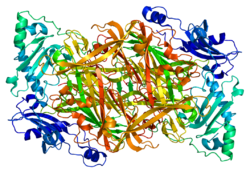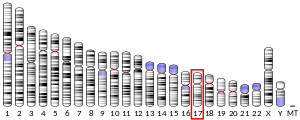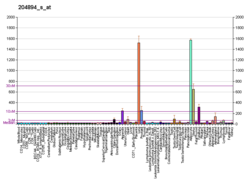VAP 1
Le VAP 1 (pour « vascular adhesion protein 1 »), dénommé également AOC3 (pour (« Amine oxidase copper containing 3 ») ou SSAO (pour « semicarbazide-sensitive amine oxidase ») est une enzyme dont le gène est AOC3, situé sur le chromosome 17 humain.
Structure et rôles
modifierLa protéine a un poids moléculaire de 170 Kilodaltons. Elle joue un rôle d'amine oxydase à cuivre. Elle est exprimée dans l'endothélium hépatique, jouant un rôle dans la fixation[5] et la migration des lymphocytes[6] (essentiellement lymphocytes Th2 alors que les Th1 utilisent une intégrine[7]). Elle joue probablement en augmentant l'expression de la sélectine E et P[8].
L'enzyme contribue également au métabolisme de plusieurs composés aminés[9].
Elle régule le transport de glucose dans les adipocytes[10] où elle est exprimée[11], en augmentant la production de peroxyde d'hydrogène, ce dernier stimulant le GLUT4 (« glucose transporter type 4 »)[12].
Une forme soluble est détectable dans le sérum des patients porteur d'une maladie hépatique chronique, responsable d'une activité de type monoamine oxydase[13]. Son taux sérique semble être régulé également par l'insuline[14], celui-ci s'élevant au cours du diabète sucré qu'il soit de type 1 ou 2. Cela pourrait augmenter la production de métabolites toxiques et contribuer ainsi aux complications du diabète[15].
Son activité s'élève également en cas d'insuffisance cardiaque[16] et est corrélé avec l'importance de l'athérome[17].
L'action de monoamine oxydase contribuerait à l'inflammation hépatique et à la fibrose de cet organe[18].
Cible thérapeutique
modifierLe vapaliximab est un anticorps monoclonal dirigé contre le VAP 1.
Notes et références
modifier- GRCh38: Ensembl release 89: ENSG00000131471 - Ensembl, May 2017
- GRCm38: Ensembl release 89: ENSMUSG00000019326 - Ensembl, May 2017
- « Publications PubMed pour l'Homme », sur National Center for Biotechnology Information, U.S. National Library of Medicine
- « Publications PubMed pour la Souris », sur National Center for Biotechnology Information, U.S. National Library of Medicine
- (en) McNab G, Reeves JL, Salmi M, Hubscher S, Jalkanen S, Adams DH, « Vascular adhesion protein 1 mediates binding of T cells to human hepatic endothelium » Gastroenterology, 1996;110:522–528
- (en) Lalor PF, Edwards S, McNab G, Salmi M, Jalkanen S, Adams DH, « Vascular adhesion protein-1 mediates adhesion and transmigration of lymphocytes on human hepatic endothelial cells » J Immunol, 2002;169:983–992
- (en) Bonder CS, Norman MU, Swain MG et al. « Rules of recruitment for Th1 and Th2 lymphocytes in inflamed liver: a role for alpha-4 integrin and vascular adhesion protein-1 » Immunity, 2005;23:153–163
- (en) Jalkanen S, Karikoski M, Mercier N et al. « The oxidase activity of vascular adhesion protein-1 (VAP-1) induces endothelial E- and P-selectins and leukocyte binding » Blood, 2007;110:1864–1870
- (en) Lyles GA, « Mammalian plasma and tissue-bound semicarbazide-sensitive amine oxidases: biochemical, pharmacological and toxicological aspects » Int J Biochem Cell Biol, 1996;28:259–274
- (en) Enrique-Tarancon G, Castan I, Morin N et al. « Substrates of semicarbazide-sensitive amine oxidase co-operate with vanadate to stimulate tyrosine phosphorylation of insulin-receptor-substrate proteins, phosphoinositide 3-kinase activity and GLUT4 translocation in adipose cells » Biochem J, 2000;350(pt 1):171–180
- (en) Stolen CM, Yegutkin GG, Kurkijarvi R, Bono P, Alitalo K, Jalkanen S, « Origins of serum semicarbazide-sensitive amine oxidase » Circ Res, 2004;95:50–57
- (en) Enrique-Tarancon G, Marti L, Morin N et al. « Role of semicarbazide-sensitive amine oxidase on glucose transport and GLUT4 recruitment to the cell surface in adipose cells » J Biol Chem, 1998;273:8025–8032
- (en) Kurkijarvi R, Yegutkin GG, Gunson BK, Jalkanen S, Salmi M, Adams DH, « Circulating soluble vascular adhesion protein 1 accounts for the increased serum monoamine oxidase activity in chronic liver disease » Gastroenterology, 2000;119:1096–1103
- (en) Salmi M, Stolen C, Jousilahti P. et al. « Insulin-regulated increase of soluble vascular adhesion protein-1 in diabetes » Am J Pathol, 2002;161:2255–2262
- (en) Meszaros Z, Szombathy T, Raimondi L, Karadi I, Romics L, Magyar K, « Elevated serum semicarbazide-sensitive amine oxidase activity in non-insulin-dependent diabetes mellitus: correlation with body mass index and serum triglyceride » Metabolism, 1999;48:113–117.
- (en) Boomsma F, van Veldhuisen DJ, de Kam PJ. et al. « Plasma semicarbazide-sensitive amine oxidase is elevated in patients with congestive heart failure » Cardiovasc Res, 1997;33:387–391
- (en) Aalto K. et al. « Soluble vascular adhesion protein-1 correlates with cardiovascular risk factors and early atherosclerotic manifestations » Arterioscler Thromb Vasc Biol, 2012;32:523–532
- (en) Weston CJ, Shepherd EL, Claridge LC et al. « Vascular adhesion protein-1 promotes liver inflammation and drives hepatic fibrosis » J Clin Invest, 2014





